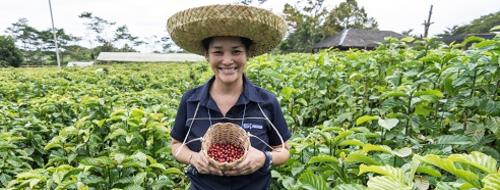Regenerative Agriculture

October to November marks the coffee harvest season, when coffee cherries reach the ideal stage for picking, particularly for farmers in Mindanao where majority of the country’s supply is produced. As the country’s biggest buyer of green coffee beans, Nestlé hopes to continuously grow its volume purchase in the Philippines. It uses as much locally-sourced Robusta coffee as possible in making NESCAFÉ, to ensure that it delivers Kapeng Pilipino Para Sa Pilipino.
However, locally-grown coffee will become harder to source if the country’s production continues to decrease. There are various factors causing this decline, with inefficient land use and degraded soil from conventional farming practices, and climate change, as major concerns. Nestlé seeks to address the impact of outdated traditional farming methods by introducing regenerative agriculture principles to smallholder farmers.
Regenerative Agriculture
Regenerative agriculture is a method of farming that aims to reverse the effects of climate change by improving soil fertility and restoring degraded soil biodiversity. Not only does it result in systemic crop health, regenerative agriculture also reduces carbon emissions and improves water systems to create an ecosystem in which a wider variety of plant and animal life can thrive. Most importantly, it mitigates the adverse consequences for the planet of food production, so that humans can continue to harvest nourishing food for many years to come.
Through the NESCAFÉ Plan program, Nestlé works closely with coffee farmers and their communities, the national and local governments, development agencies, and other partners to promote a comprehensive regenerative agriculture model that protects the three key resources of any agricultural system: soil, water, and biodiversity.
While fostering economic viability in coffee farming, the NESCAFÉ Plan also seeks to support farmers in crossing the threshold from sustainability to regeneration. To this end, the program has been sharing Good Agricultural Practices (GAP) in coffee production with farmers and introducing them to regenerative farming principles that will help make coffee-growing more viable for the long term. This is a crucial step in achieving resiliency against the threat of climate change.
Rising temperatures, extreme weather conditions, soil erosion, and other effects of climate change are increasingly impacting Filipino farming communities and putting food security at risk. Action is urgently needed to help farmers future-proof their farms and ensure adequate food for coming generations.
This is the reason behind the recent launch of Nescafé Plan 2030, an extensive strategy to accelerate coffee farmers’ adoption of regenerative agriculture, with Nestlé to invest over one billion Swiss francs by 2030. Farmers will be provided training, technical assistance, and high-yielding coffee plantlets to help them transition to regenerative coffee farming practices with these key components:
Cover Crops
Planting cover crops protects the soil. It also helps add biomass that can increase soil organic matter and thus soil carbon sequestration. A good example of a cover crop is peanut grass (Arachis pintoi), an ideal option for its efficiency in nitrogen fixation.
Composting
By using compost, farm waste is reduced and finds good use, contributing to fertility which is essential for good soil health. Compost can be made by mixing organic matter such as grass cuttings, leaves or stems, allowing decomposition into a form of soil in a pile or containers. To accelerate decomposition, earthworms such as African Night Crawlers can be added to quickly convert organic farm waste into compost. This is called vermicomposting.
Agroforestry
Agroforestry involves planting large shade trees around a farm to act as a natural barrier that protects it from wind and rain, and helps preserve biodiversity. Falcata, ipil-ipil, and fruit trees such as langka and avocado are commonly used trees on Philippine farms.
Intercropping
The practice of growing two or more crops simultaneously, intercropping is a useful way for farmers to diversify incomes. It maximizes the use of land and other resources, and increases soil health while contributing to climate resilience. Vegetables for intercropping include eggplant, chayote, pepper, banana (lakatan or saba), and peanut.
The NESCAFÉ Plan is one of the most successful and longest-running public-private partnerships in the country’s coffee industry. Under a banner project of the program since 2018, some 1,500 selected coffee farmers have been introduced to these four regenerative agriculture practices.
Today, a majority of coffee farms involved with the NESCAFÉ Plan have implemented intercropping planting systems.
Regenerative agriculture contributes to drawing down carbon dioxide from the atmosphere and reducing greenhouse gas emissions.
Nestlé sees sustainability as the first step on the road to Net Zero greenhouse gas emissions. This is an exciting time in a shared journey from sustainability towards regenerative agriculture, one that looks at renewing the world of coffee to uplift farmers’ livelihoods and lives with every cup.
When coffee enthusiasts choose coffee that is home-grown in the Philippines, they are supporting coffee farmers as they strive to practice regenerative agriculture, to become more productive, profitable, and resilient.


